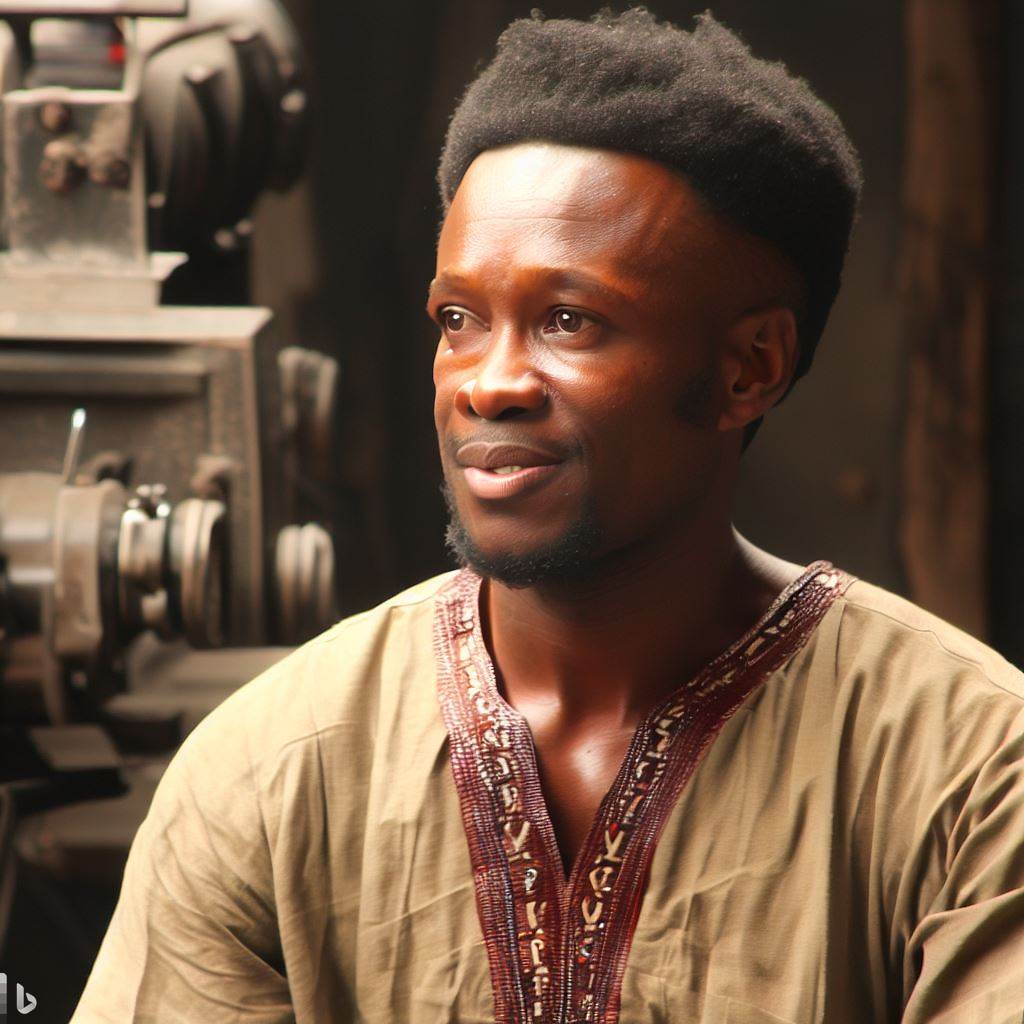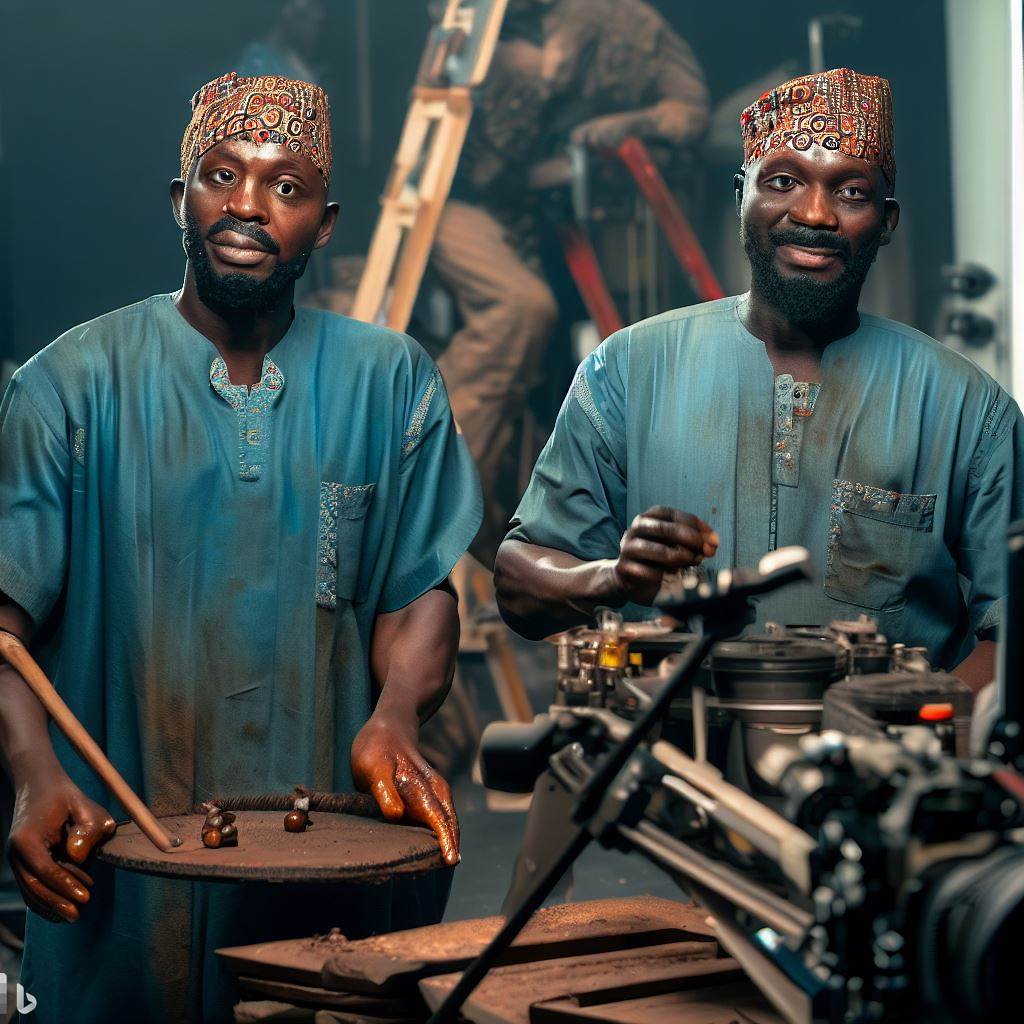Introduction
Nigerian films have gained immense popularity on a global scale. These movies have managed to captivate audiences worldwide with their compelling storylines, vibrant visuals, and powerful performances.
However, there is another element that contributes significantly to the overall cinematic experience – Foley artistry.
Foley artistry involves creating and adding sound effects to a film during the post-production phase.
By using various objects and tools, Foley artists enhance the realism of the on-screen action, bringing it to life for viewers.
This technique has become a crucial component of Nigerian cinema, elevating its quality and impact. In many prominent Nigerian films, the intricate use of Foley artistry is evident.
From the sound of footsteps on different surfaces to the rustling of clothing and the clashing of weapons, every detail is meticulously crafted to intensify the viewer’s immersion.
These skilled artists play a vital role in creating a believable and immersive world that complements the visuals.
For instance, the acclaimed film “The Wedding Party” showcases the expertise of Foley artists in its wedding scene.
The sound of champagne glasses clinking, laughter echoing, and dance floor footsteps all contribute to the authenticity and vibrancy of the moment.
Such attention to detail through Foley artistry enhances the audience’s emotional connection and overall experience.
Summarily, the growing popularity of Nigerian films can be attributed to various factors, including their compelling narratives and exceptional performances.
However, the role of Foley artistry cannot be overlooked. Through this technique, these films are able to create a more immersive and captivating cinematic experience.
In the following sections, we will explore specific prominent Nigerian films and dive deeper into the fascinating world of Foley artistry behind them.
Understanding Foley Artistry
A. Foley artistry and its significance in filmmaking
In the world of filmmaking, Foley artistry is an integral part that brings films to life by creating realistic sound effects.
Foley artistry involves the reproduction of everyday sounds that are added to a film during the post-production stage.
These sounds can be anything from footsteps and ambient noises to the opening of doors or the clinking of glasses.
Foley artistry plays a significant role in enhancing the audience’s immersion and emotional connection to the story being told.
It adds layers of depth to the visuals, making the viewing experience more engaging and believable.
Without Foley artistry, films would feel incomplete and lack the necessary audio cues that help evoke the desired emotions.
B. Foley artists and their role in creating sound effects
Foley artists are skilled professionals who specialize in creating sound effects for films.
They work closely with the director, sound editors, and sound designers to ensure that the sounds they create align perfectly with the visuals on screen.
Using various props and tools, Foley artists meticulously reproduce sounds that mimic the actions and movements of the characters on screen.
They may use different types of shoes to create specific footsteps, or experiment with different surfaces to generate the right texture for a particular sound effect.
Foley artists rely on their creativity and attention to detail to produce sounds that are authentic and synchronized with the film’s narrative.
C. Why Foley artistry is crucial in Nigerian films
Foley artistry is particularly crucial in Nigerian films due to the unique storytelling style and cultural context. Nigerian films, also known as Nollywood, often rely on dialogue and music to drive the narrative.
However, adding Foley sound effects helps elevate the overall quality and cinematic experience.
Nigerian films are known for their dramatic scenes and high-energy performances. Foley artistry enhances the impact of these moments by providing additional sensory cues that immerse the audience in the story.
Whether it’s the sounds of a bustling market or the suspenseful footsteps in a thrilling chase sequence, Foley artistry in Nigerian films heightens the emotional connection and creates a more immersive viewing experience.
Furthermore, Nigeria’s film industry has witnessed tremendous growth in recent years, with Nollywood becoming the second-largest film industry globally.
As the industry continues to evolve, there is a need for greater attention to detail, including sound design.
Foley artistry plays a vital role in ensuring that Nigerian films meet the international standards of audiovisual production.
In fact, Foley artistry is a significant aspect of filmmaking, providing realistic sound effects that enhance the audience’s viewing experience.
Foley artists are essential contributors in the creation of these sound effects, utilizing their skills and creativity to reproduce everyday sounds.
In the context of Nigerian films, Foley artistry plays a crucial role in immersing the audience in the storytelling process and elevating the overall cinematic experience.
As the Nigerian film industry continues to thrive, the importance of Foley artistry in maintaining the industry’s growth and international recognition cannot be overstated.
Read: Interviews with Successful Foley Artists in Nigeria’s Film Industry
Prominent Nigerian Films
A. Overview of popular Nigerian films that have gained international recognition
- “The Wedding Party” directed by Kemi Adetiba is a hilarious romantic comedy that broke box office records.
- “Half of a Yellow Sun” directed by Biyi Bandele explores the impact of the Nigerian Civil War.
- “Lionheart” directed by Genevieve Nnaji is Nigeria’s first official submission to the Oscars.
- “October 1” directed by Kunle Afolayan combines a crime thriller with Nigeria’s struggle for independence.
- “The Figurine” directed by Kunle Afolayan follows the journey of two friends who discover a cursed artifact.
B. The unique storytelling and visual elements of these films
These Nigerian films captivate audiences worldwide with their rich storytelling and distinct visual styles.
- Engaging narratives that tackle a wide range of topics, from romance and comedy to war and historical events.
- Authentic portrayal of Nigerian culture, traditions, and societal issues, providing a fresh and relatable perspective.
- Innovative cinematography techniques, showcasing the beauty of Nigerian landscapes and urban environments.
- Creative use of music and sound to enhance the emotional impact of key scenes and create a memorable experience.
C. Introduction to the specific Nigerian films to be discussed regarding Foley artistry
In this section, we will delve into the fascinating world of Foley artistry in prominent Nigerian films.
- “The Wedding Party” – This blockbuster film features dynamic sound effects that complement the comedic timing and fast-paced nature of the story.
- “Half of a Yellow Sun” – The Foley work in this film adds realism and intensity to the war scenes, transporting viewers to the heart of the conflict.
- “Lionheart” – The subtle but effective use of Foley helps immerse the audience in the corporate world, emphasizing the characters’ struggles and emotions.
- “October 1” – Foley plays a crucial role in building suspense and enhancing the atmospheric quality of this crime thriller.
- “The Figurine” – This film’s intricate sound design and Foley artistry contribute to the eerie and mystical elements of the storyline.
By examining the Foley artistry in these Nigerian films, we can appreciate the importance of sound in cinematic storytelling.
Stay tuned as we explore the meticulous techniques and creative processes behind Foley in Nigerian cinema!
Read: Music Directors’ Contribution to Nigerian Cultural Heritage
Foley Artistry in King of Thieves
A. King of Thieves and its impact on Nigerian cinema
King of Thieves is a captivating Nigerian film that has made a significant impact on the country’s cinema industry.
With its compelling storyline and exceptional production values, it has garnered both critical acclaim and commercial success.
B. Specific Foley techniques used in King of Thieves
The Foley artists in King of Thieves employed various techniques to enhance the film’s auditory experience.
They meticulously crafted and merged different sound effects to create a seamless and immersive environment for the viewers.
Using innovative techniques such as surface Foley and spot Foley, the artists accurately replicated everyday sounds, ensuring that each action and movement had a distinct and realistic presence in the film.
They used a wide array of objects and props to recreate sounds that corresponded with the on-screen visuals.
C. Notable sound effects created by Foley artists in King of Thieves
1. Footsteps
The Foley artists carefully crafted the sound of footsteps to match each character’s movement and personality.
They used various shoes and walking surfaces to create a diverse range of footstep sounds, from light and brisk to heavy and deliberate.
This attention to detail enhanced the characterization and added depth to the film.
2. Weaponry
In intense fight scenes, the Foley artists were responsible for creating realistic sounds for weapons such as knives, swords, and firearms.
They used a combination of props, such as metal objects and wooden boards, to simulate the impact and movements associated with these weapons, amplifying the tension and excitement on screen.
3. Environmental Sounds
Foley artistry played a crucial role in recreating the atmosphere and ambiance of different scenes.
From bustling marketplaces to serene natural landscapes, the artists meticulously recreated the sounds of everyday life, immersing the audience in the film’s setting and enhancing their emotional connection to the story.
4. Object Interaction
Foley artists also focused on creating realistic sounds for objects interacting with one another. This included the clinking of glassware, the opening and closing of doors, and the handling of various items.
These detailed sounds added another layer of authenticity to the film, making the on-screen world more believable and relatable.
In essence, the Foley artistry in King of Thieves showcases the tremendous talent and dedication of Nigerian filmmakers and sound artists.
Through their meticulous attention to detail and creativity, they were able to elevate the film’s auditory experience, immersing the viewers into the story’s world.
King of Thieves stands as a testament to the importance of Foley artistry in Nigerian cinema and its contribution to the overall cinematic experience.
Read: Nollywood and Animation: An Unfolding Narrative

Foley Artistry in Shanty Town
A. Shanty Town and its Contribution to the Nigerian Film Industry
Shanty Town, a low-income area in Nigeria, has made significant contributions to the country’s film industry.
Despite limited resources, Shanty Town has become a hub for creativity and innovation in filmmaking.
B. Specific Foley Techniques Used in Shanty Town
Foley artists in Shanty Town employ various techniques to create realistic sound effects for films.
They rely on their imagination and resourcefulness to produce sounds through everyday objects and unconventional means.
C. Remarkable Sound Effects Created by Foley Artists in Shanty Town
- Creating rain sounds by pouring water onto tin roofs, simulating a downpour in a film scene.
- Using sandpaper and stones to mimic footsteps on different surfaces, enhancing the realism in action sequences.
- Producing gunfire sounds by clapping two wooden blocks together, adding intensity to thrilling moments in movies.
- Imitating animal sounds like growls and howls by manipulating their own voices, capturing the essence of wildlife on screen.
- Recreating vehicle noises by scraping metal against concrete or revving motorcycle engines, immersing viewers in chase scenes.
These examples demonstrate the incredible ingenuity and talent of Foley artists in Shanty Town.
Their ability to transform ordinary objects into extraordinary sounds is truly remarkable.
Without the sophisticated equipment available in larger studios, they rely on their creativity.
The Foley techniques employed in Shanty Town have not only elevated the quality of Nigerian films but have also inspired filmmakers worldwide.
The resourcefulness exhibited by these artists is a testament to their passion for storytelling and dedication to their craft.
By showcasing their work, Nigerian films have gained global recognition and cemented Shanty Town’s reputation as a hub for artistic excellence.
In review, Shanty Town’s contribution to the Nigerian film industry cannot be overstated.
The Foley artistry in this low-income area has produced incredible sound effects that enrich the cinematic experience.
Through their creative techniques, Foley artists in Shanty Town have proven that talent and imagination can thrive even in challenging circumstances.
Their work serves as an inspiration to aspiring filmmakers, demonstrating that true artistry knows no boundaries.
Read: Challenges and Solutions for Nigerian Foley Artists: A Discussion
You Might Also Like: Marketing Your Makeup Artistry Skills in the Digital Age: Nigeria’s Perspective
Foley Artistry in Tatu
A. Tatu and its cultural significance in Nigerian cinema
Tatu, a popular Nigerian film, holds great cultural significance in Nigerian cinema. It showcases the country’s talent, storytelling, and rich cultural heritage.
B. The specific Foley techniques used in Tatu
The Foley artists in Tatu employed various techniques to enhance the film’s audio experience. They meticulously created sounds to closely match the actions on screen.
- Footsteps: Foley artists emphasized the unique sound of each character’s footsteps, ensuring they resonated with their personality and the environment.
- Props: By manipulating everyday objects, Foley artists created realistic sounds for the characters’ interactions with various props, adding depth to the storytelling.
- Cloth Movement: The rustling sound of fabric was meticulously crafted, capturing the texture, weight, and movement of the characters’ attire.
- Weapons: Foley artists developed distinct sounds for weapons, such as swords clashing or guns firing, to intensify the action sequences.
C. Extraordinary sound effects created by Foley artists in Tatu
The Foley artistry in Tatu took the film’s auditory experience to a whole new level, captivating the audience with extraordinary sound effects.
- Rainfall: Foley artists ingeniously replicated the sound of rainfall, combining various techniques to mimic droplets, thunder, and the overall ambience.
- Animal Sounds: Whether it was the distant roar of a lion or the subtle chirping of birds, Foley artists skillfully crafted realistic animal sounds, adding authenticity.
- Fight Scenes: The intense fight scenes became more impactful with the Foley artists’ creation of bone-crunching punches and bone-breaking impacts.
- Car Chases: Foley artists mesmerized the audience with their creation of screeching tires, engine revs, and crashes during thrilling car chase sequences.
In Tatu, the Foley artistry successfully contributed to the film’s immersive experience, bringing the story to life through exceptional sound design.
In Nigerian cinema, films like Tatu continue to showcase the talent and creativity of Foley artists, highlighting their crucial role in filmmaking.
The meticulous attention to detail, distinctive techniques, and extraordinary sound effects crafted by Foley artists in Tatu demonstrate their dedication and skill.
Through their artistry, Foley artists contribute significantly to the success and cultural significance of Nigerian films, making them a vital part of the industry’s growth and recognition.
Impacts of Foley Artistry on Nigerian Films
A. Foley Artistry Enhancing the Overall Cinematic Experience
- Foley artistry adds a realistic and immersive element to Nigerian films.
- It enhances the sound effects, making the viewing experience more engaging.
- The use of Foley artistry creates a sense of authenticity and believability in the film.
- Viewers are able to feel more connected to the characters and their surroundings.
- The attention to detail in Foley artistry elevates the production value of Nigerian films.
- It adds depth and dimension to the storytelling, enhancing the emotional impact on the audience.
- With Foley artistry, Nigerian films are able to compete on a global scale in terms of technical quality.
- The skillful use of Foley artistry can create suspense, tension, and excitement in scenes.
- Nigerian filmmakers are utilizing Foley artistry to create a more memorable and immersive film experience.
- Overall, Foley artistry plays a crucial role in enhancing the overall cinematic experience in Nigerian films.
B. The Role of Foley Artistry in Capturing the Essence of Nigerian Stories and Culture
- Foley artistry allows Nigerian films to accurately portray the sounds and noises of everyday life.
- It captures the unique cadences of Nigerian languages, giving authenticity to the dialogue.
- The use of Foley artistry in Nigerian films preserves and promotes Nigerian cultural heritage.
- It helps depict traditional ceremonies, rituals, and celebrations realistically.
- Foley artists play a pivotal role in recreating the sounds of Nigerian instruments and music.
- Nigerian folklore and mythological elements are brought to life through Foley artistry.
- It amplifies the cultural nuances and diversity portrayed in Nigerian films.
- Foley artistry showcases the rich oral tradition of storytelling in Nigerian culture.
- Sound effects created through Foley artistry contribute to the narrative and character development.
- The use of Foley artistry ensures that Nigerian stories and culture are accurately represented.
C. The Potential for Nigerian Films to Showcase the Talent of Foley Artists Globally
- Nigerian films have gained international recognition, creating opportunities for Foley artists to showcase their talent.
- Foley artistry in Nigerian films has the potential to attract a global audience.
- As Nigerian films continue to gain popularity, the demand for skilled Foley artists will increase.
- Nigerian Foley artists can exhibit their creativity and expertise to a wider, international audience.
- International exposure can lead to collaborations between Nigerian and foreign Foley artists.
- Foley artistry in Nigerian films can inspire and influence filmmakers and artists worldwide.
- Recognizing the talent of Nigerian Foley artists can contribute to the appreciation of African cinema.
- Global recognition for Foley artistry in Nigerian films can open doors for international collaborations and projects.
- Nigerian Foley artists can establish themselves as industry professionals on a global scale.
- Ultimately, Nigerian films have the potential to propel the talent of Foley artists to global acclaim.
Learn More: Balancing Risk and Artistry: Circus Life in Nigeria
Conclusion
Foley artistry plays a significant role in Nigerian films by enhancing the auditory experience.
The future potential of Nigerian cinema and Foley artistry is promising, with growing recognition and opportunities for development.
As Nigerian films gain global recognition, the creativity and innovation of Foley artists will continue to evolve, captivating audiences worldwide.
Publish Your Professional Profile, Business or Brand
Showcase your expertise, gain trust, and boost visibility instantly on Professions.ng.
Publish Now



